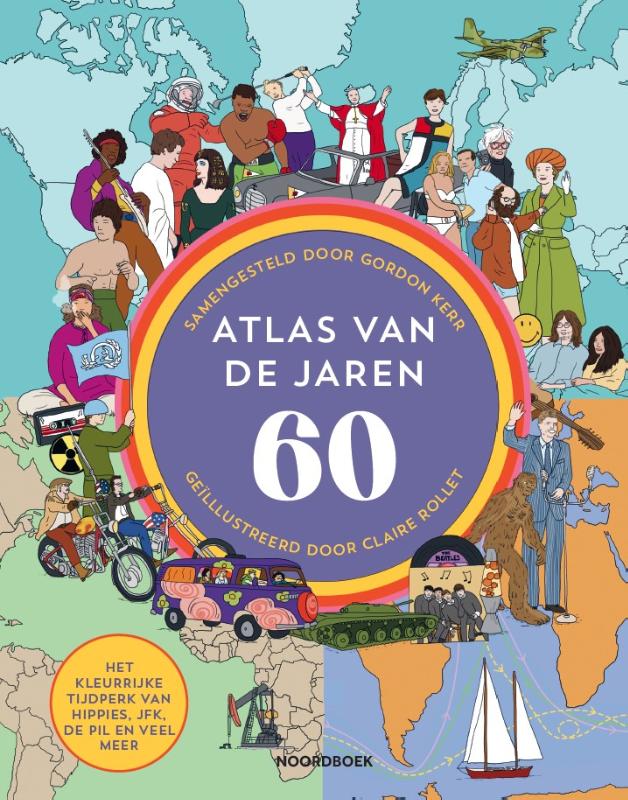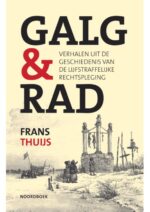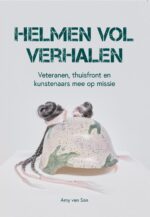Atlas van de jaren 60
€ 29,90
De jaren zestig waren iconisch. Dit boek brengt dat vernieuwende decennium in kaart aan de hand van getekende figuren, kaarten en infographics. We zien waar bekende bands werden opgericht, welke mode opkwam en hoe de anticonceptiepil zijn intrede deed. Op zowel serieuze als grappige wijze tonen de kleurrijke kaarten wat er speelde op het gebied van cultuur, politiek, technologie en wetenschap.
Naast de donkere kanten van het tijdperk (de schokkende moorden op Martin Luther King en JFK bijvoorbeeld) laat het boek vooral zien hoe vernieuwend, invloedrijk en kleurrijk dit decennium was.
Gordon Kerr werkte bij een uitgeverij en in een boekhandel voordat hij fulltime schrijver werd. Hij is de auteur van verschillende korte geschiedenisboeken en heeft een fascinatie voor de jaren zestig. Claire Rollet is een Frans illustrator.
Gerelateerde boeken
-
-
Helmen vol verhalen
€ 25,00Helmen Vol Verhalen is een landelijk project waarin veteranen worden gekoppeld aan kunstenaars, die het persoonlijke missieverhaal van de veteraan vertalen in een kunstwerk waarin de ‘helm’ als metafoor voor het militaire beroep is verwerkt. In het boek Helmen Vol Verhalen worden de verhalen van de veteranen opgenomen en ook het verhaal van de kunstenaar achter het werk. Het vertelt waarom en hoe het kunstwerk tot stand is gekomen. Op de voorgrond staat het verhaal van de veteraan, over ‘op missie gaan’. Veel Nederlanders kunnen zich daar niets bij voorstellen. Deze verhalen geven een indrukwekkend inzicht in de werkelijkheid en de impact dat het heeft op de veteranen en hun thuisfront.
Als oud-matroos en veteraan leidt Amy van Son het project Helmen vol verhalen. ‘In vroegere tijden rukte het hele dorp uit om haar krijgers binnen te halen na een veldslag. Dat kun je je nu niet meer voorstellen. Zeker niet als het ‘jonge’ veteranen betreft. Om weer meer begrip en erkenning voor veteranen te krijgen, moeten burgers weten wat het betekent om naar een oorlog gestuurd te worden. Maar veel veteranen vinden het moeilijk hun ervaringen onder woorden te brengen. Daarom laten we veteranen hun verhaal vertellen aan een kunstenaar. Die vertaalt dat naar een kunstwerk. Het proces, het eindresultaat en de band die daaruit ontstaan, zijn helend.’
Ook voor Amy zelf. ‘De onthulling van elk kunstwerk – tweeëntwintig tot nu toe – emotioneert me telkens weer. Want door iets te betekenen voor anderen, erken ik ook mezelf.’Amy van Son brengt met Helmen vol verhalen een eerbetoon aan degenen die hun leven gewijd hebben aan de bescherming van vrijheid en vrede. Dit boek is een diepgaande en aangrijpende ervaring die je kijk op oorlog, moed en menselijkheid zal veranderen.
-
Spitten voor de vijand
€ 21,95Meer dan honderdduizend mannen werden vanaf september 1944 opgeroepen om te werken aan Duitse verdedigingswerken in Nederland. In de nog bezette provincies werden de arbeiders gedwongen tewerkgesteld aan de bouw van tankgrachten, loopgraven en schuttersputjes, vaak onder slechte omstandigheden. Voor de Duitsers was het belang groot om de geallieerden zo lang mogelijk tegen te houden. Er werd dan ook hard opgetreden tegen weigeraars.
Voor velen waren de principiële bezwaren te groot, zij besloten onder te duiken. Anderen hadden die mogelijkheid niet. Zij probeerden zich aan te passen aan de omstandigheden en saboteerden waar ze maar konden. Een groot deel van deze zogenoemde spitters zag kans om te vluchten of keerde niet terug van verlof. Zij waren daarna veroordeeld tot een leven als onderduiker. Zij die als onderduikers tijdens de vele razzia’s, of door verraad, werden gepakt, kwamen na een verblijf in een gevangenis in een strafkamp in Duitsland of Drenthe terecht.
Eén van die mannen was Eelke Dijkstra. Samen met dertig anderen werd hij in november 1944 vanuit het Huis van Bewaring in Leeuwarden overgebracht naar Yde, een klein Drents dorpje onder de rook van Groningen. Zijn oorlogsdagboek was voor zijn kleinzoon en auteur Erik Dijkstra aanleiding om onderzoek te doen naar het vergeten strafkamp in Yde. Wat volgde was een reis door de geschiedenis waarin bijzondere ontdekkingen werden gedaan en veel betrokkenen voor het eerst hun verhaal vertelden. Door intensief archiefonderzoek kwamen schokkende feiten boven water over vier gefusilleerde dwangarbeiders in november 1944. De vele brieven, dagboeken en getuigenissen vertellen samen het verhaal van strafkamp Yde en de tewerkstelling in Drenthe.
Erik Dijkstra is schrijver/journalist en doet al jaren onderzoek naar de tewerkstelling in Drenthe.




